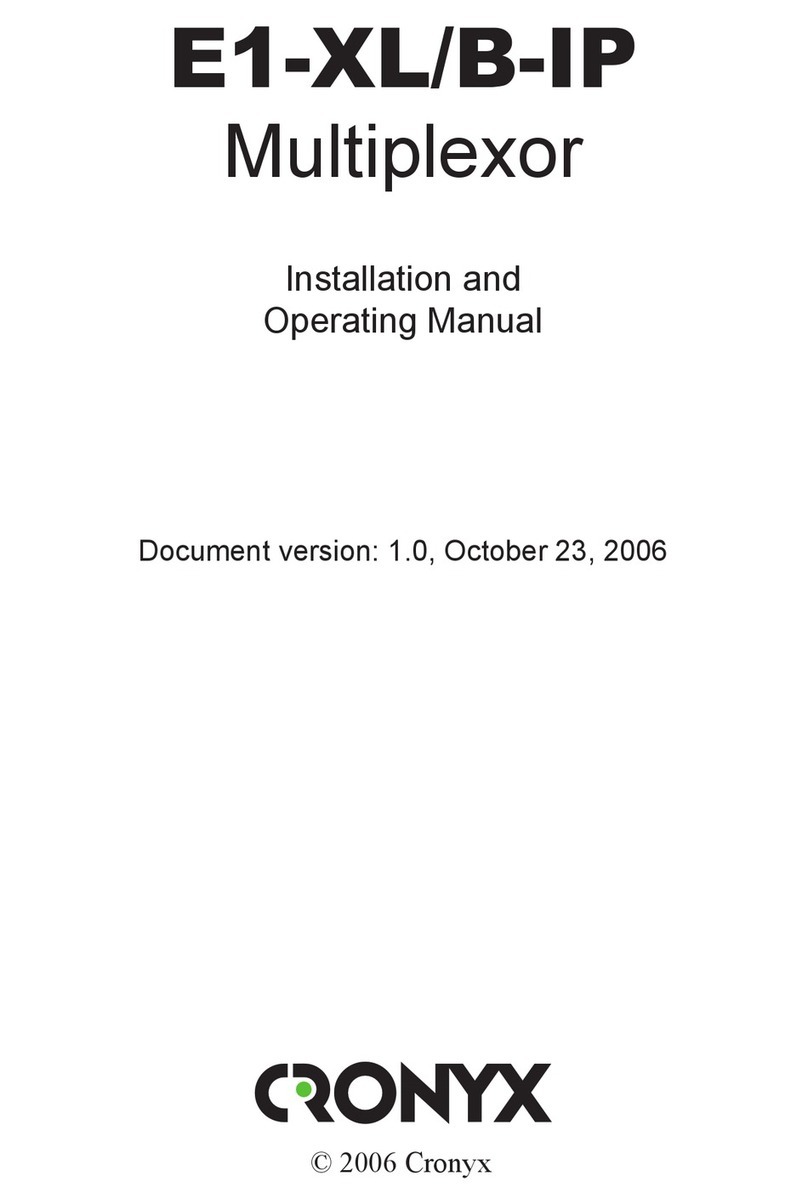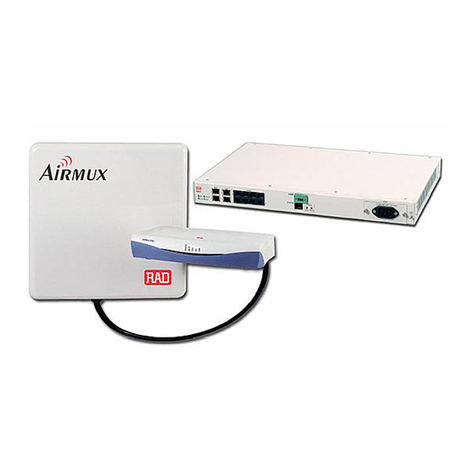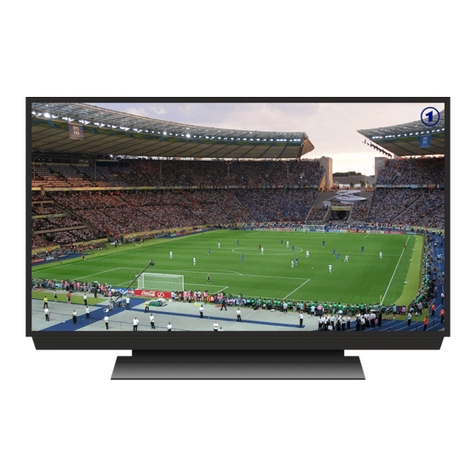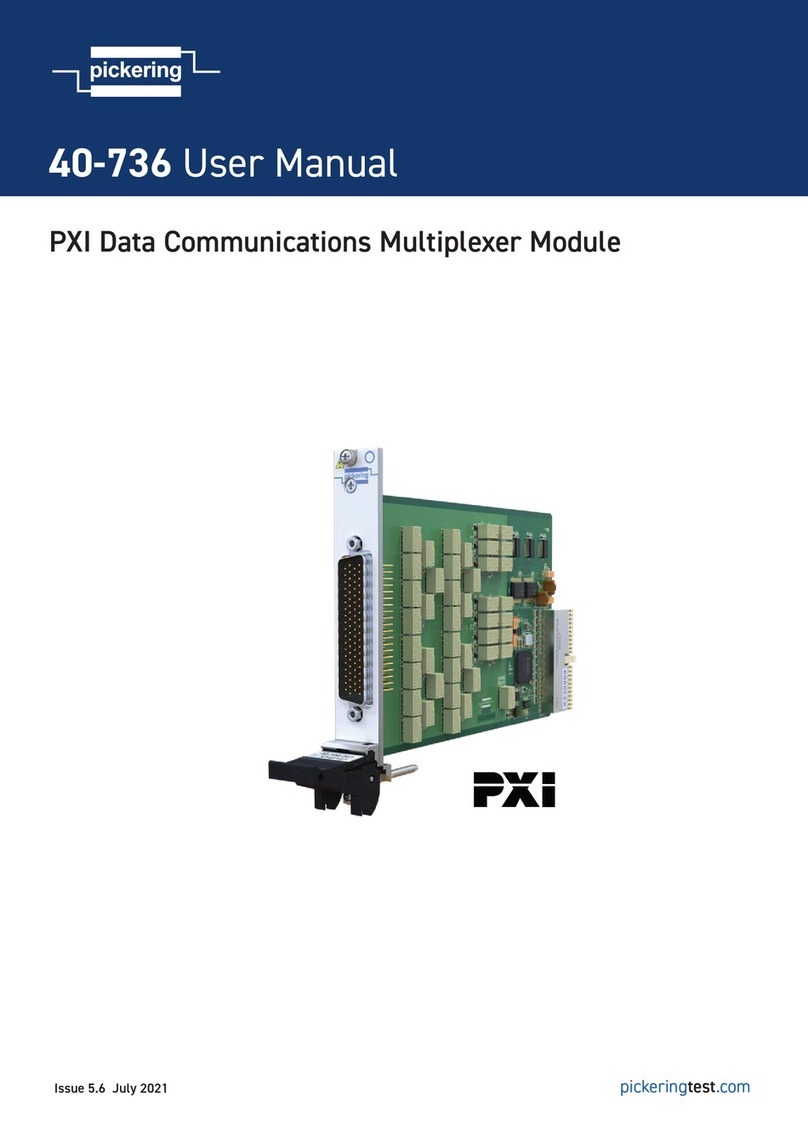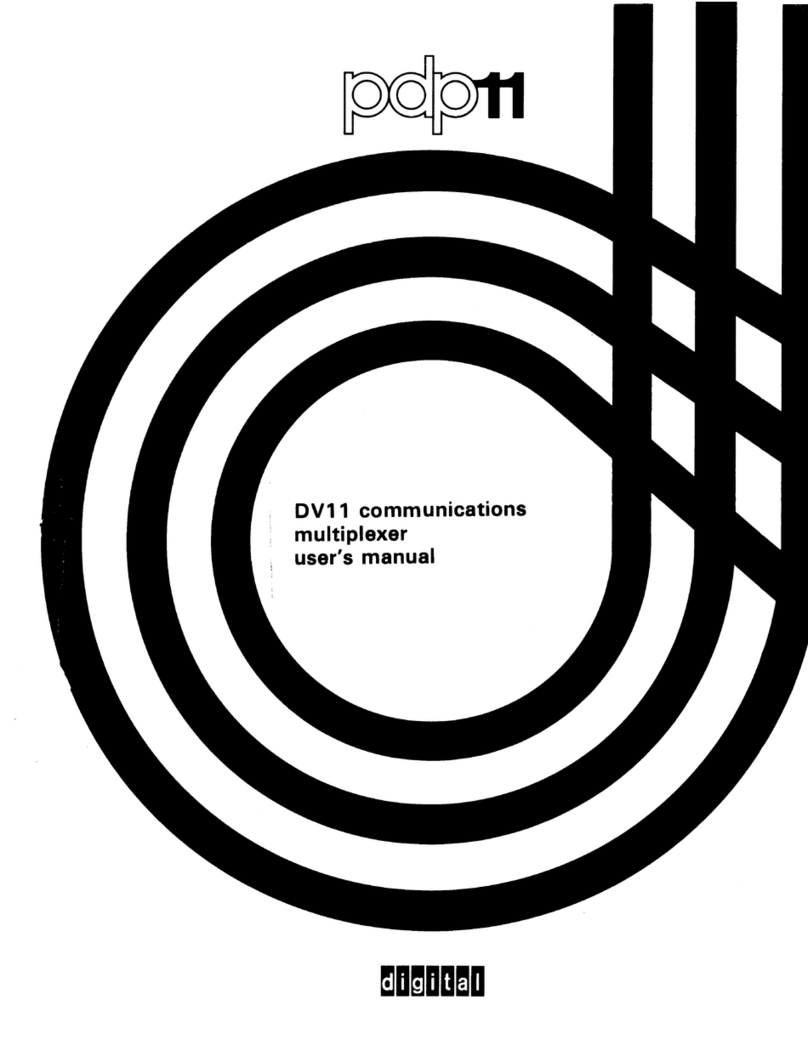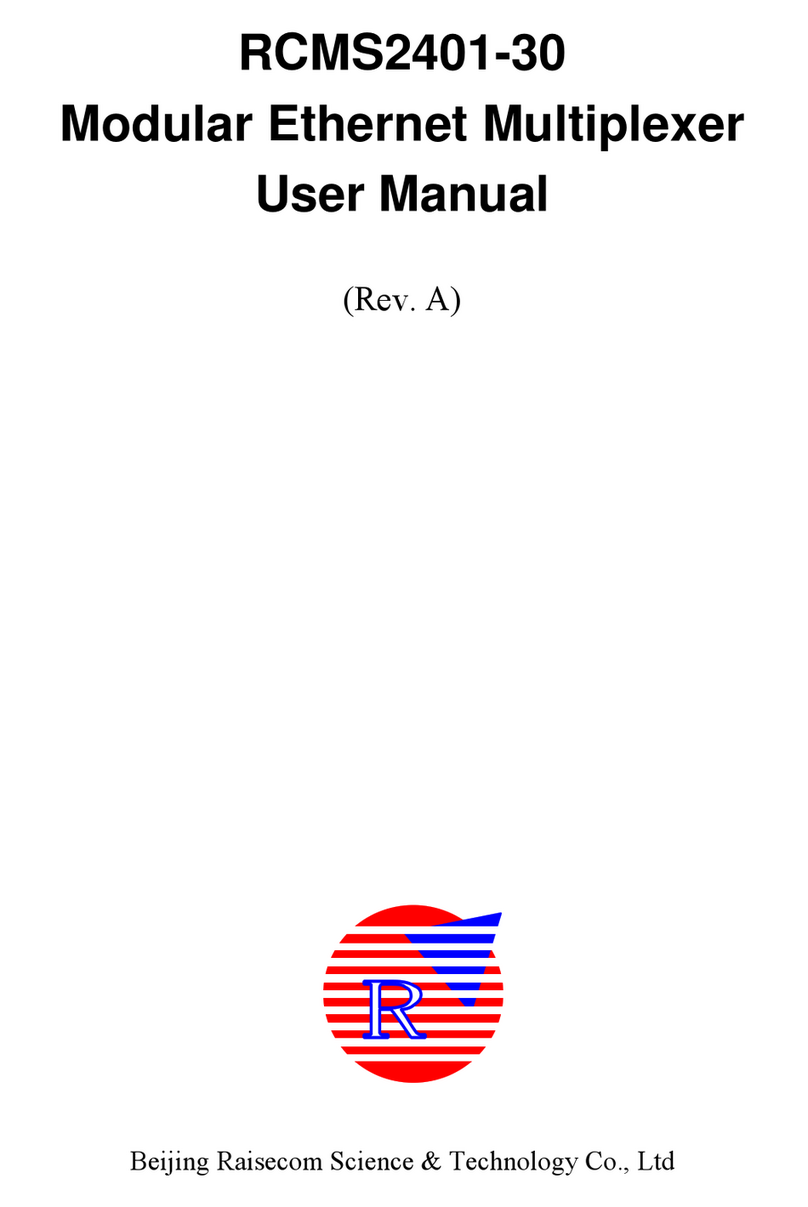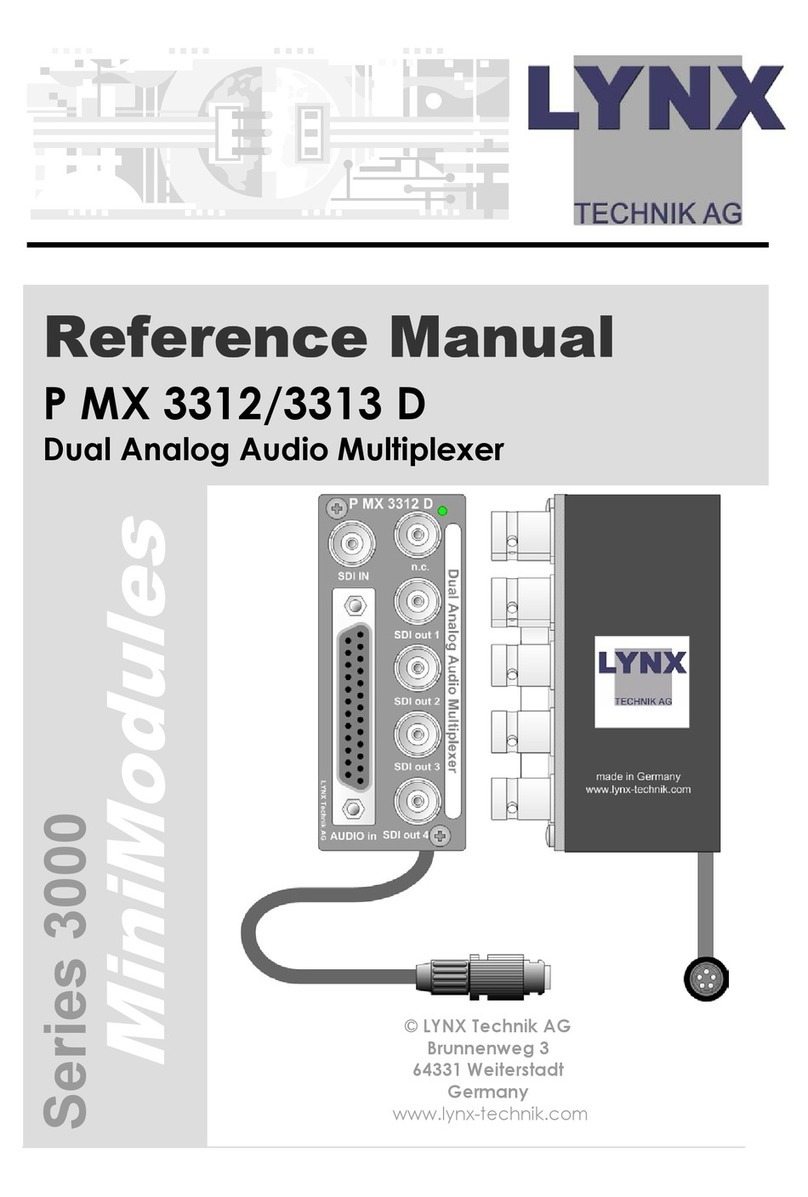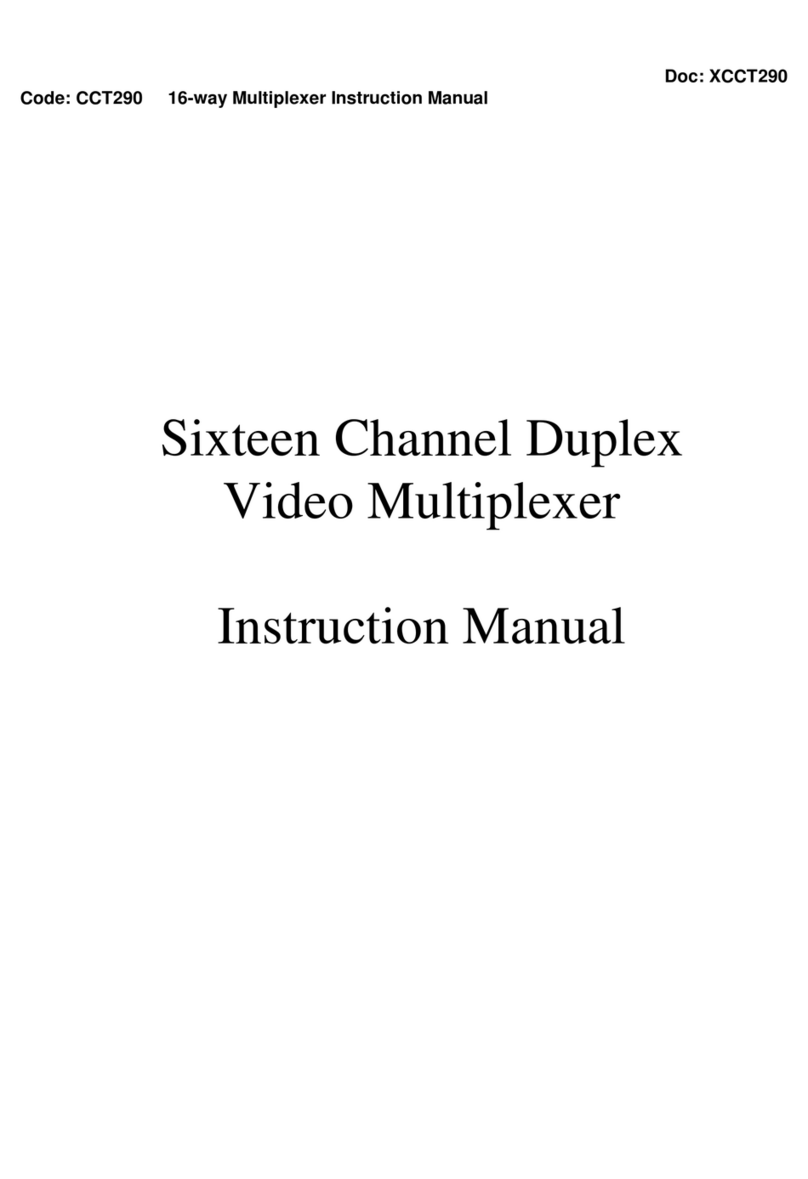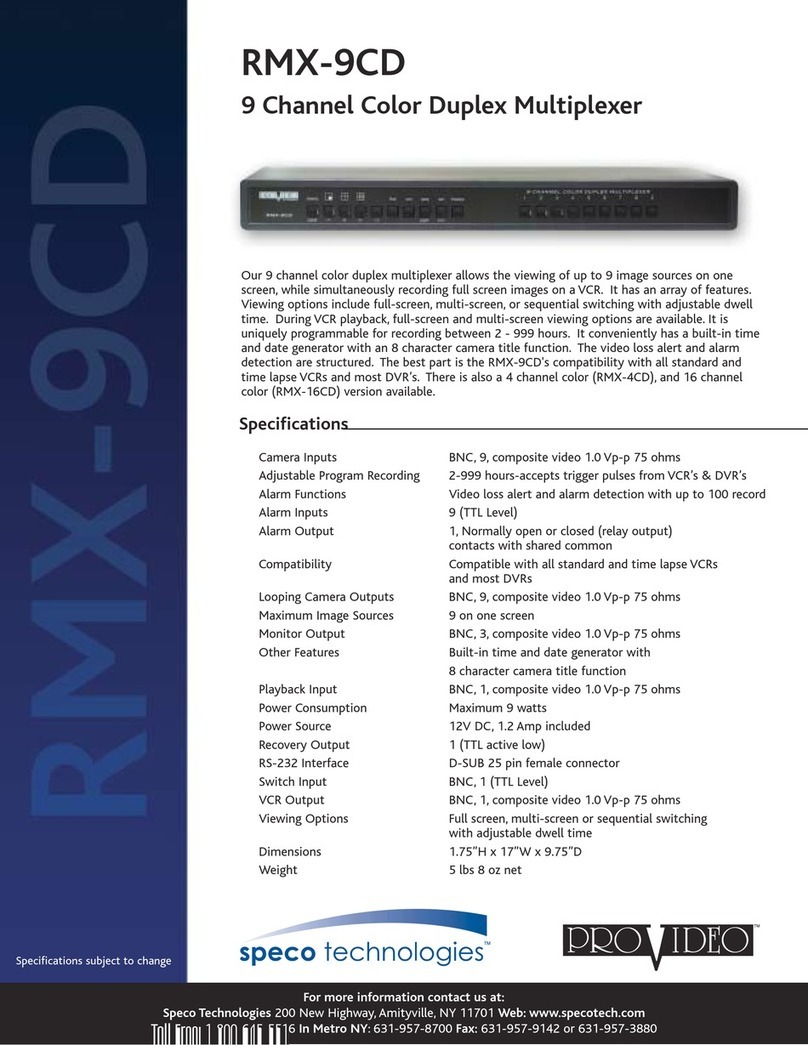Datum 5094-101 User manual

-c:c·1
1111111
PERIPHERAL
EQUIPMENT
DIVISION
INSTRUCTION
MANUAL
MODEL
5094-101
TWO-PORT
MULTIPLEXER
PUBLICATION
NO.
1802.3
••••••••••••••••
••••••••••

SEPTEMBER
1974
DATUM
I
NC.
1363
South
State
College
Boulevard
Anaheim,
California
92806
PERIPHERAL
EQUIPMENT
DIVISION
INSTRUCT
ION
MANUAL
MODEL
5094-101
TWO-PORT
MULTIPLEXER
PUBLICATION
NO.
1802.3

Section
II
111
IV
v
TABLE
OF
CONTENTS
GENERAL
DESCRIPTION
1•1
1•2
1.3
1.4
Introduction
••••••••••
0
•••••••••••••••.••
Purpose
of
Equipment
•••••••.••••••••••••
Physical
Description
•••••••••••.••••••••
Functional
Description
••••••••••••••••••
INSTALLATION
AND
OPERATION
2.
1
2.2
2.
2.
1
2.2.2
2.3
Genera1
Installation
••••.•••••••••
~
•••••••••••••
Power
•••.•••••••••••••••••••••••••••••
• •
Interface
Connectors
••••••••••••••••••••
Operation
•••••••••••••••••••••••••••••••
THEORY
OF
OPERATION
3. 1
3.2
3.3
3
.3.
1
3.3.2
3.3.3
3.3.4
3.3.5
3.4
3.5
Genera1
Block Diagram
Description
•••••••••••••••
Logic
Description
•••••.•••••••••••••••••
Cont
ro
1
Log
i c
••••••
~
•••.••••••••••••••••
Data Input
Bus
••••••••.•••••••••••••••••
Address
Bus
••••.••••••••••••••••••••••••
Data Output
Bus
•••••••••••••••••••••••.•
Control
Signals
Repowering
•••••••••.••••
Logic Elements
······················~···
Logic
Symbols
•..•.•.••••••••••••.•.•••••
MAINTENANCE
4.
1
4.2
4.2.l
DRAWINGS
General
Maintenance Aids
•••.••••.••.••••••••••••
Drawings
••••••••••••••••••••••••••••••••
1-1
1-1
1-1
1-2
2-1
2-1
2-1
2-1
2-2
3-1
3-1
3-1
3-1
3-2
3-2
3-2
3-2
3-2
3-3
4-1
4-1
4-1

1.1
INTRODUCTION
SECTION
I
GENERAL
DESCRIPTION
This
technical
manual
contains
operating,
installation,
and
maintenance
information
for
the
DATUM
Model
5094-101
Multiplexer.
The
manual
is
organized
in
five
sections.
Section
I
contains
general
phy-
sical
and
functional
information,
Section
II
contains
information
for
installing
and
operating
the
Multiplexer,
and
Section
Ill
includes
Mul-
tiplexer
theory
at
the
block
diagram and
logic
level.
Sections
IV
and
V,
respectively,
contain
maintenance
information
and
the
reference
draw-
ings.
1.2
PURPOSE
OF
EQUIPMENT
The
Model
5094-101
Multiplexer
allows
the
connection
of
two
peripheral
devices
to
the
IBM
1130
SAC
channel.
A
typical
application
would be
the
connection
of
a
magnetic
tape
system and a
high-speed
line
printer
to
the
IBM
1130.
1.3
PHYSICAL
DESCRIPTION
The
Multiplexer
(Drawing 5094-101)
consists
of
a
printed
cir-
cuit
card
and a power
supply
mounted
in
a 19"
x·
3.5
11
x
13
11
box. The box
is
furnished
with
standard
RETMA
hole
spacing
for
the
3.5
11
high
front
panel.
The
front
panel
contains
the
power
on-off
pushbutton,
and
the

rear
panel
contains
the
connectors
for
interfacing
the
computer and
per-
ipheral
devices.
1.4
FUNCTIONAL
DESCRIPTION
The
Model
5094-101
Multiplexer
receives
and
repowers
all
the
signals
to
and from
the
computer and
peripheral
devices.
It
controls
and
determines
the
priority
of
the
cycle
steal
operations
of
the
two
peripheral
devices.
Connectors
Jl02
and J103
are
identical
to
the
IBM
SAC
channel.
1-2

SECTION
11
INSTALLATION
AND
OPERATION
2.
1
GENERAL
This
section
of
the
manual
describes
the
installation
and
operation
of
the
Model
5094-101
Multiplexer.
2.2
INSTALLATION
The
Multiplexer
is
shipped
fully
assembled
and
ready
for
oper-
ation.
No
assembly
is
required
other
thar'I
connection
of
the
Multi_Plexer
to
a
source
of
AC
power and
connection
of
the
computer and
peripheral
device
interface
cables.
2.2.
l Power
The
Multiplexer
operates
on
120/230-volt,
60 Hz,
single-phase
power. Connect
the
AC
source
to
the
Hubbel
connector
provided
on
the
rear
panel
of
the
Multiplexer.
Ensure
that
a 2-ampere
Slo~Blo
fuse
is
installed
in
the
fuse
socket.
2.2.2
Interface
Connectors
The
functions
of
the
interface
connectors
located
at
the
rear
of
the
Multiplexer
are
listed
in
Table
2.1.
2-1

The
signal
cable
from
the
IBM
1130
SAC
channel
is
plugged
into
connector
JlOl.
The
signal
cable
from
the
higher
priority
device
connects
to
Jl02,
and
the
signal
cable
from
the
lower
priority
device
connects
to
Jl03.
2.3
OPERATION
If
only
one
device
is
to
be
operated,
the
connector
for
the
second
device
must be
left
open.
It
makes
no
difference
which
connec-
tor
is
used
for
a
single
device.
Tab 1e
2.
1.
I
nte
rf
ace
Connector
Functions
CONNECTOR
FUNCTION
JlOl
Interface
to
the
computer
J
lo2
Channel I ] I -
highest
priority
Jl
03
Channel •
2•
-1
owe
st pr io r i ty
2:-2

SECTION
Ill
THEORY
OF
OPERATION
3.1
GENERAL
The
theory
of
operation
describes
the
detailed
functions
of
the
Model
5094-101
Multiplexer.
The
descriptions
begin
at
the
block
diagram
level
and
then
proceed
through
descriptions
of
the
logic
dia-
gram.
3.2
BLOCK
DIAGRAM
DESCRIPTION
(DRAWING
800526)
The
block
diagram shows
the
flow
of
the
data
to
and from
the
computer and
peripheral
devices.
The
arrows show
the
direction
of
the
data
flow.
The
sheet
numbers
shown
in
each
box
refer
to
the
sheet
numbers
of
Drawing 76085 where
that
particular
logic
is
shown.
The
control
lines
(out
of
the
control
logic)
which
control
some
of
the
gating
functions
are
now
shown.
The
block
diagram shows
the
IBM
1130
SAC
channel
on
the
right-
hand
side
of
the
drawing;
the
two
peripheral
devices
are
shown on
the
left-hand
side.
The
SAC
Device #1
is
the
higher
priority
device.
3.3
LOGIC
DESCRIPTION
3
.3.
l
Control
Logic (76085,
Sheet
1)
This
logic
handles
the
priority
of
the
cycle
steal
requests
from
the
two
peripheral
devices.
3-1

Flip-flop
REQ
is
the
channel
cycle
steal
request.
B
is
used
to
synchronize
the
incoming
cycle
steal
request
with
the
phase A
signal
from
the
computer
when
the
computer
is
in
the
wait
mode
and
no
T
clocks
are
available.
SELl
determines
which
device
is
to
be
serviced.
3.3.2 Data Input Bus (76085,
Sheet
2)
This
logic
receives
the
16-bit
data
words from
the
two
peri-
pheral
devices
and
OR
1s them
to
drive
the
data
input
bus
of
the
SAC
channe1.
3.3.3 Address
Bus
(76085,
Sheet
3)
This
logic
receives
the
16-bit
address
words from
the
two
per-
ipheral
devices
and
gates
one
of
them, depending on which
is
being
ser-
Viced
at
the
time,
out
onto
the
address
bus
of
the
SAC
channel.
3.3.4
Data Output
Bus
(76085,
Sheet
4)
This
logic
receives
the
16-bit
data
word from
the
SAC
channel
and repowers
it
for
the
two
peripheral
devices.
3.3.5
·control
Signals
Repowering (76085,
Sheets
5 and 6)
This
logic
receives
the
control
signals
from
the
SAC
channel
and repowers them
for
the
two
peripheral
devices.
3.4
LOGIC
ELEMENTS
All
logic
elements
are
Signetics
TTL
or
Utilogic
integrated
circuits
in
dua1-inline
packages.
Logic diagrams
for
these
elements
can be found
at
the
back
of
this
section.
3-2

The
logic
elements
are
mounted in
wire-wrap
sockets
on
printed
circuit
cards.
All
circJit
interconnections
are
made
by
wire-wrap
con-
nections.
Circuit
elements
are
easily
replaceable
by removing them from
their
sockets
and
replacing
them
with
equ!valent
elements.
Integrated
circuits
are
used
throughout
wherever
possible.
Exceptions
are
relay
and
lamp
drivers.
3.5
LOGIC
SYMBOLS
The
logic
symbols
are
derived
from MIL-STD-806B, and
they
are
utilized
in such a manner
that
signals
can be
traced
through
the
logic
in
terms
of
''high
11
and
"low"
(+2.5
to
+5V)
and
(OV)
by
examination
of
the
logic
symbols
without
the
need
to
memorize
the
electrical
characteristics
(NANO,
NOR,
AND,
OR,
etc.)
of
the
circuits
(which most
other
logic
draw-
ing schemes
require).
The
"high"
and "low"
signal
level
indication
is
illustrated
by
a
straight
line
for
a
11
high"
signal
and a
small
circle
for
a
11
low
11
·signal
level.
The
following
symbol
shapes
are
used:
D
"OR"
SYMBOL
D
11
AND
11
SYMBOL
The use
of
straight
lines
or
circles
at
inputs
and
outputs
of
these
basic
symbols
completely
defines
the
function
the
circuit
performs,
the
input
signal
levels
required
to
activate
the
circuit,
and
the
output
signal
level
when
the
circuit
is
activated.
3-3

Some
examples
follow:
) >
NOR
Either
(or
both)
'ii
Inputs
11
High
11
·
TYPE
7402
INTEGRATED
CIRCUIT
-~o
Both
Inputs
11
Low
11
NANO
Output
is
11
Low
11
Output
is
11
High
11
) )
OR
Either
A
(or
both)
Inputs
11
High"
TYPE
SP384
INTEGRATED
CIRCUIT
Output
is
11
High"
-Oo~
Both
Inputs
''Low''
3-4
AND
Output
is
"Low'
1
0
0
NOR
Either
A Output
(or
both)
is
Inputs
11
High
11
''Low''
TYPE
7400
INTEGRATED
CIRCUIT
··-
.
Both
Inputs
11
High
11
NANO
Output
is
11
LovJ';

Note
that
the
Type 7402
integrated
circuit
can
be
used
as
a
"high"
input
NOR
or
a
11
low
1
input
NANO.
Note
also
that
the
Type 7400
integrated
circuit
can
be
used
as
a
11
low
1
input
NOR
or
a
'.'high"
input
NANO.
Note
that
the
Type
SP
384
integrated
circuit
can
be
used
as
. a
"high"
input
OR
or
a
11
low
11
input
AND.
A
11
low
wired
OR
11
or
a
''high
wired
AND
11
function
can
also
be
Implemented
with
certain
integrated
circuits
by
tying
the
outputs
together
and
adding
an
external
discrete
resistor
"pull
up."
+5
"Pull
Up
11
'Resistor
1.
11
Low
Wired
OR"
(Any
NANO
gate
output
goes
11
Jow
11
the
bus
goes
11Jow.
11
)
2.
11
Hi gh
Wired
AND"
All
NANO
gate
outputs
must
be
11
high
11
"'frlorder
for
the
bus
to
be
"high.
11
3-5

Four-To-Ten-Line
Decoder
Decodes
"High"
8-4-2-1
BCD
Inputs
2 4 8
0 2 3 4 5 6 7 8 9
,
11.
I I I I I I I t
"/'
Decoded
Output
Goes
11
Low
11
114..;TO-lO-LINE
DECODER"
SYMBOL
J-K
Flip-Flop
sets
ff
(when 1'1ow'1)
J
enable·
(when
11
high
11
)
·.Clock
(upon
transition
to
11
Jow
11
)
K
enable
(when
"high")
resets
ff
(when
11
Jow
11
)
J
9
CL
K
3-6
6
s
R.
J
Q
Q
True
output.
(ff
·is
11
set
11
when Q
is.
11
high
11
)
False
output.
(ff
is
11
reset"
when Q
is
11
high
11
)

J-K
FLIP-FLOP
TRUTH
TABLE
Input
Levels
Flip-Flop
State
Before
C1ock
After
Clock
J K
Low
Low
Same
as
Before
Clock
Low
High
Reset
,
High
Low
Set
High High
Opposite
of
Be-
fore
Clock
As
illustrated
in
the
Truth
Table,
the
J-K
flip-flop
has
no
"forbidden"
combination
for
its
J and K
inputs.
If
both
inputs
are
enabled,
the
clock
merely
causes
the
flip-flop
to
toggle
to
the
.QE.E.Q.-
site
state.
3-7

SECTION
IV
MAINTENANCE
4.
I
GENERAL
This
section
contains
corrective
and
preventive
maintenance
information
for
the
Model
5094-101
Multiplexer.
Effective
maintenance
of
the
Multiplexer
requires
an
adequate
understanding
of
the
logic
theory.
4.2
MAINTENANCE
AIDS
The
maintenance
aids
associated,with
the
Multiplexer
are
the
drawings in
Section
V.
4.
2.
I Drawings
The drawing complement
consists
of
the
following:
a.
Top
Assembly Drawing 5094-101
·b.
Block Diagram 800526
c.
Logic Diagrams 76085
d.
Card Assembly Drawings 76085
e.
Power Supply
Schematic
940015
f.
Power Supply Assembly 940015
g.
AC
Wiring Diagram 800918
The
block
diagram
illustrates
the
system
in
terms
of
each
functional
logic
block.
The
sheet
number
in
each
block
refers
to
the
sheet
number
of
Drawing 76085 where
that
logic
is
located.
4-1

The
logic
diagrams
furnish
the
logic
mechanization
details
of
the
Multiplexer.
The.physical
location
of
each
logic
element
is
designated
on
the
diagrams
by
chip
location
on
the
card.
The
chip
location
designation
corresponds
to
the
column
(A
through
N)
and
row
(1
through
6) in which
the
chip
is
located
on
the
card.
The
IC
chip
type
can be
determined
either
by
examination
of
the
chip
on
the
card
in
the
column/row
given,
or
by
inspection
of
the
assembly drawing
for
the
card.
4-2

Drawing
Number
Rev.
800526
None
940015
c
940015
c
5094-101
A
76085,
of
7 C
76085,
2
of
7 C
76085,
3
of
7 C
76085,
4
of
7 C
76085,
5
of
7 C
76085,
6
of
7 C
76085,
7
of
7 C
800918
None
SECTION
V
DRAWINGS
Title
1130
Multiplexer
Block Diagram
Power Supply Assembly
Power
Supply Schematic
Top
Assembly,
1130
Multiplexer
1130
Multiplexer
Control
1t30
Multiplexer
Data Input
Bus
Address
Bus
·
Data Output
Bus
Re-Powering
Control
Signals
Re-Powering
Control
Signals
Re-Powering
AC
Wiring Diagram
5-1

SAC
DEVICE
#1
SAC
DEVICE
#2
Jl02
I
,I
I
I
,I
'.
I
'1
LTR
DATA
INPUT
ADORE
SS
DATA
OUTPUT
REVISIONS
DESCRIPTION
I
I
I.
I.
I'
I
I
3llt:O
Dt.T!O
1e~
1130
SAS
80052G

i
...
..
. !
.I
l
GU
2N371S
RE.VISIONS
LTR
DESCRIPTION
CAIE
c.':;;?4

MTG.
SURFACe
OF
TRAl./SFORMcZ
EE:P.C,KET
~
HEA7
Sll./K
70
Be
0/J
GAME
PLANE:
.
TRAl.IS.
BRki.
P/N
700533-1,
FAR5!CE
P//.J
700535-Z~
N.EA/25/N;
IRAJJ5F'OR/./.EJZ,
P//.J
9/<l-023
REVISIONS
LTR
DESCRIPTION
c
l.170U/JTcP
W/Tf{
EX
rC>SE;;
CC::PP'EZ.
SVl?Fl';CE,
/VcAJ<SID/£
GMVI
FUSc
SAMP
Rc:c11F1E1<..
('o::s
1)
P//J
V.~·'/43
1.11Fe.
c=.a.r-.
8US
8AZ..
P/IJ
7009-1-1-1,
l/E~ZS!C~
P/;J
70c:>':;>'1-I-
2)
Fhi?SiDG
DAIE
Table of contents
